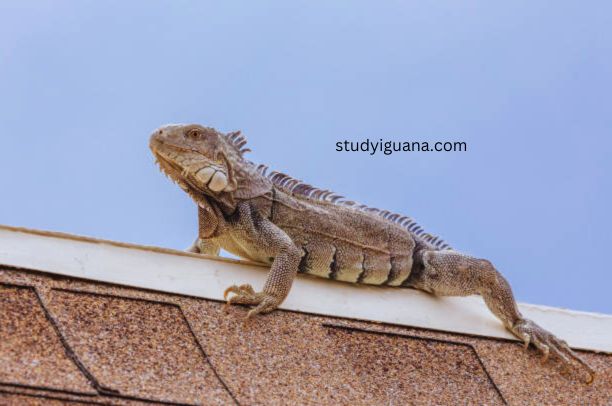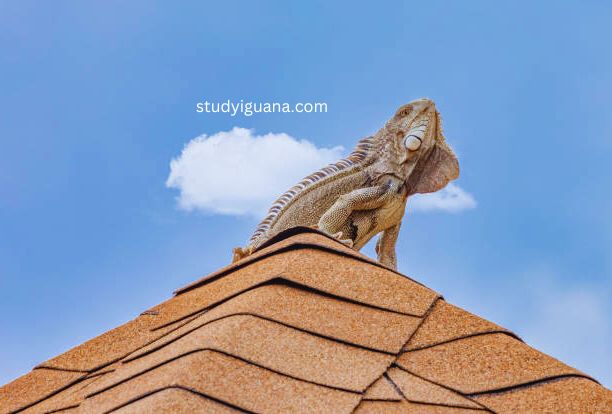A Guide how to get rid of iguanas on roof? How do I get rid of iguanas on a roof? The tropical allure of an exotic locale often comes with unexpected challenges, and for homeowners in certain regions, the presence of iguanas on roofs has become a common predicament. These arboreal reptiles, with their distinctive scales and impressive size, may seem like fascinating creatures from a distance. However, when they decide to take up residence on your property, particularly on the roof, their presence can lead to a myriad of issues, ranging from structural damage to potential health concerns.
In this guide, we’ll delve into the reasons why iguanas find rooftops appealing, the risks associated with their presence, and, most importantly, effective and humane methods for getting these uninvited guests off your roof and keeping them at bay. How do I get rid of iguanas on a roof? Whether you’re a homeowner dealing with a persistent iguana problem or simply curious about preventative measures, read on to discover practical solutions for maintaining an iguana-free environment above your head.
Introduction
A brief overview of the issue
The increasing presence of iguanas on roofs, drawn to elevated spaces for shelter, poses challenges for homeowners, encompassing structural damage and health concerns. This guide explores the reasons behind this issue and provides practical solutions for how to get rid of iguanas on roof?
The importance of addressing the problem
Addressing the iguana-on-roof issue is crucial to prevent structural damage and mitigate potential health risks associated with their presence, safeguarding the well-being and integrity of the property.
Purpose of the guide
The guide aims to provide homeowners with practical insights and effective solutions for addressing and preventing iguana infestations on roofs, offering a comprehensive resource to maintain a secure and iguana-free living space.
Understanding the Iguana Menace
The section on “Understanding the Iguana Menace” explores why iguanas are attracted to rooftops, common regions facing infestations, and the potential risks and damages associated with their presence, providing essential knowledge for effective management.
Why are iguanas attracted to rooftops?
Iguanas are attracted to rooftops for several reasons. The elevated position provides them with a vantage point for sunbathing and surveillance, offering warmth and safety. Additionally, rooftops often mimic natural basking sites, making them appealing habitats for these arboreal reptiles.

Common regions facing iguana infestations
Iguana infestations are commonly found in regions with tropical or subtropical climates, including areas such as Florida, the Caribbean, and parts of Central and South America. These warm environments provide ideal conditions for iguanas to thrive, leading to increased occurrences on rooftops and in residential areas.
Potential risks and damages associated with iguana presence on roofs
The presence of iguanas on roofs poses various risks and damages, including structural concerns such as damaged shingles and roof materials due to their claws. Iguana droppings can also lead to health hazards and carry bacteria. Additionally, their burrowing activities may compromise the integrity of roofs, presenting potential safety and maintenance issues for homeowners.
Identifying Signs of Iguana Infestation
Identifying signs of an iguana infestation involves observing physical evidence on the roof, such as scratches or droppings. Property damage and health concerns for residents, including the presence of nests or eggs, are also indicators that help homeowners recognize and address the issue effectively.
Physical evidence on the roof how to get rid of iguanas on roof?
Physical evidence of the iguana’s presence on the roof includes distinctive scratch marks or abrasions caused by their claws. Additionally, the accumulation of iguana droppings in and around the area is a clear sign of their activity. Homeowners should inspect these visible clues to assess the extent of the infestation and determine appropriate removal measures.
Damage to property
Iguanas can cause damage to property, especially on roofs, by scratching surfaces with their claws, creating unsightly marks, and potentially compromising the structural integrity. This damage can result in the need for repairs and maintenance to ensure the longevity and safety of the affected structures. So you need to know how to get rid of iguanas on roof?
Health concerns for residents
The presence of iguanas on roofs raises health concerns for residents due to the potential transmission of diseases through contact with their droppings. Iguana feces may harbor bacteria, posing a risk of infection, especially if residents come into direct or indirect contact with contaminated areas. Vigilance and proper cleaning practices are essential to mitigating the health concerns associated with iguana infestations .
Humane Methods how to get rid of iguanas on roof?
How do I get rid of iguanas on a roof? Humane iguana removal methods encompass natural repellents, such as citrus or pepper sprays, and modifying the environment to make rooftops less appealing. DIY techniques, like installing barriers or providing alternative basking spots, can be effective. In cases requiring professional intervention, ethical removal services should be considered to ensure the humane treatment of the iguanas.
DIY methods for deterring iguanas
DIY methods for deterring iguanas include:
Natural Repellents:
Create a spray using ingredients like citrus or hot pepper, applying it to areas frequented by iguanas.
Modifying the Environment
- Trim overhanging branches and foliage to limit access.
- Use mesh or barriers to block potential entry points.
- Introduce decoy predators, like motion-activated devices or statues, to discourage iguanas.
These approaches aim to create an inhospitable environment for iguanas, encouraging them to seek alternative locations away from your property.
Professional removal services
When DIY methods prove insufficient, professional removal services become essential. Key considerations include:
Engage professionals promptly to prevent further damage and address the infestation swiftly.
Timely Intervention how to get rid of iguanas on roof?
Expertise in Humane Removal:
Choose services experienced in humane iguana removal, prioritizing the well-being of the reptiles.
Evaluation and Prevention how to get rid of iguanas on roof?
Select for providers who assess the property, identify entry points, and implement preventative measures to deter future infestations.
Selecting a reputable professional ensures effective and ethical iguana removal while safeguarding the integrity of your property.
Preventative Measures on how to get rid of iguanas on roof?
Implementing these preventative measures creates an inhospitable environment, reducing the likelihood of iguana infestations and the need for extensive removal efforts.
Securing entry points
- Seal gaps, cracks, and openings in structures to prevent iguana entry.
- Install mesh or barriers in vulnerable areas like vents and gaps beneath roofs
Landscaping practices to discourage iguanas
- Choose plants that are less appealing to iguanas.
- Trim trees and vegetation to reduce access points and discourage nesting.
Regular maintenance to prevent reinfestation
- Conduct regular property inspections for signs of iguana activity.
- Promptly address any potential entry points or conditions that may attract iguanas.
Legal and Ethical Considerations on how to get rid of iguanas on roof?
Adhering to legal guidelines and ethical considerations ensures responsible and compassionate handling of iguana-related issues while promoting coexistence with local wildlife.
Understanding local regulations
- Research and comply with local laws regarding the removal of iguanas.
- Obtain the necessary permits or permissions if required.
Ethical treatment of iguanas during removal
- Prioritize humane practices to minimize stress and harm to the iguanas.
- Consider relocation to suitable habitats, adhering to ethical standards for wildlife management.
Case Studies and Success Stories on how to get rid of iguanas on roof?
Exploring case studies and success stories provides valuable firsthand experiences, offering a diverse range of effective strategies and insights for readers dealing with iguana-related issues.
Real-life examples of successful iguana removal
- Highlight instances where homeowners or professionals effectively removed iguanas from roofs.
- Discuss specific strategies, challenges faced, and the positive outcomes achieved.
Lessons learned from homeowners who tackled the issue effectively
- Share insights from homeowners who successfully managed iguana infestations.
- Emphasize practical tips, innovative solutions, and lessons that can benefit others facing similar challenges.
Conclusion
In this guide, we’ve explored the challenges posed by iguanas on rooftops and provided a comprehensive approach for homeowners. How do I get rid of iguanas on a roof? From understanding why iguanas are drawn to rooftops to implementing humane removal methods and preventative measures, the guide covers key aspects of managing infestations. Emphasizing legal compliance and ethical treatment, it also includes real-life case studies for practical insights. By applying the information herein, homeowners can effectively address and prevent iguana-related issues, fostering a secure coexistence with the local environment.
FAQS
What will keep iguanas away?
To keep iguanas away, use natural repellents, install physical barriers, remove attractants, modify landscaping, deploy decoy predators, or consider professional removal services.
Why are iguanas attracted to rooftops?
Iguanas are drawn to rooftops for elevated sunbathing spots and shelter, mimicking their natural habitat.
What are the potential risks of iguana presence on roofs?
Risks include structural damage from claws, health concerns from droppings, and safety issues due to burrowing activities.
How can I deter iguanas using DIY methods?
Use natural repellents like citrus sprays, modify the environment by trimming vegetation, and employ barriers to limit access.
When should I consider professional removal services?
Professional services are advisable for severe infestations or when DIY methods prove ineffective, ensuring humane and effective removal.
What legal and ethical considerations should I be aware of?
Understand local regulations for iguana removal and prioritize humane treatment, considering the well-being of the reptiles during the process.
